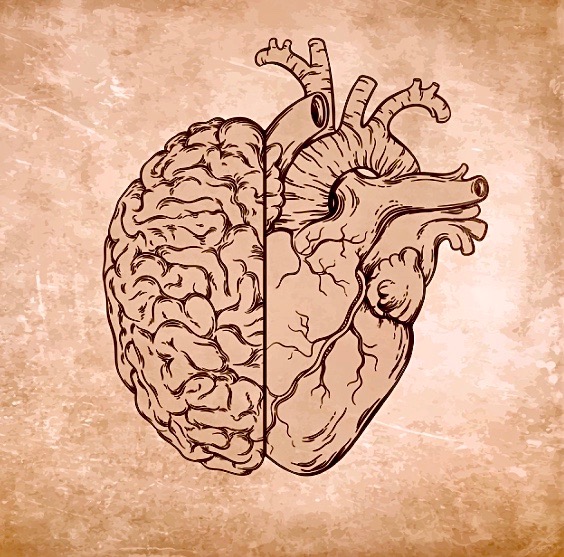
In trauma treatment, we are looping our consciousness around places in our psyches and in our bodies that hold unprocessed sensations, emotions, images, and thoughts. Like dusting off old furniture or opening boxes that were pushed into the back of an attic, healing involves going into the recesses of the mind and heart. We bring the light of conscious awareness to our wounds—we attend to the pain so that we can feel integrated and whole.
While it can initially feel frightening to revisit difficult memories, it can also feel empowering to reduce the power they hold over us. Lingering feelings of anxiety, shame, powerlessness, or frozenness need our unconditional acceptance in order to heal. This asks us to suspend any tendency to make ourselves wrong for feeling hurt. Instead, we learn turn towards our pain with love and compassion.

Trauma treatment typically involves three phases of care. Phase one focuses on establishing stability and safety, phase two focuses processing traumatic material in a well-paced, regulated manner, and phase three involves the integration of new experiences into identity and relationships. In a previous post on Neuropsychotherapy, I discuss how healing can be described in 6 Rs: Relating, Resourcing, Repatterning, Reprocessing, Reflecting, and Resilience.
As applied to our phase-based model of care, Relating involves building a trusting relationship where you feel understood, respected, supported, and protected. From here, you focus on Resourcing which involves developing healthy coping strategies that enhance stabilization through a readily accessible feeling of safety in body and mind.
Once your resources are in place, you can begin to work through traumatic memories through Repatterning and Reprocessing. Repatterning involves integrating new movement resources that may not have been available to you at the time of the traumatic event. Reprocessing involves revisiting a traumatic memory by talking about it or writing about it while introducing new information facilitates an experience of resolution and reduced distress. The purpose of this article is to deepen your understanding of these key components in phase two of trauma treatment.
Within phase three, you are able to Reflect upon the past and be mindful about the beliefs that you carry about yourself and the meaning that you attribute to your life. You begin to experience yourself as more Resilient in body and mind. It is wise to remember that any healing journey is not linear. As discussed in The Post Traumatic Growth Guidebook:
“There is no stage of trauma treatment that is better or worse than any other. Healing does not exist on a hierarchy, and there is no rush to a finish line. Moreover, growth is often uneven. You might discover parts of yourself that feel tender and in need of care, whereas other more resolved parts are ready to expand and grow.”
Dr. Arielle Schwartz

Trauma treatment involves a balance of top-down and bottom-up processing.
Top-down processing engages upper brain centers through psychoeducation and cognitive interventions that help to regulate emotional distress. Top-down strategies include psychoeducation, talking about traumatic events, identifying negative thought patterns or thinking errors, and cultivating resources such as positive beliefs or imagery.
Bottom-up processing refers to engaging lower brain centers by bringing attention to sensations and emotions in order to access the way trauma is held in the body. Bottom-up strategies include focusing on emotions and sensations while processing traumatic events, conscious breathing, and inviting movements to facilitate somatic release. Here is where
We can use top-down and bottom-up strategies to help you work through traumatic memories. You can engage new somatic experiences that repattern your body while reviewing traumatic events and blocking beliefs to help reprocess these painful memories.
Let’s take a closer look…

When we observe the natural world, we see that animals have natural, inborn survival instincts that help them respond to threatening experiences. Animals flee from predators, signal their capacity to fight by baring their teeth and claws, or rely upon a freeze response to survive. Once the threat is over, animals typically release the physiological impact of threatening experiences by shaking in order to return to healthy movement.
Similarly, most people curl their bodies inward when exposed to traumatic events. This defensive posture is a result of contractions in the psoas and hip flexor muscles. This posture prepares the body for a fight or flight response. Once we are safe, the muscular contraction releases which can result in a trembling through the legs and upper body or a release of emotions.
Children often have this natural propensity towards shaking when frightened; however, many adults tend to suppress this natural response. In part, this is because many of us have grown up within a culture of stillness. We have been taught to sit still in school as a sign of obedience and respect. Many of us have learned to disconnect from the body. Moreover, when trauma is ongoing or chronic, that experience of safety where we can shake it off doesn’t happen. As a result, the body can hold onto the impact of unresolved stress, and this tension can accumulate with ongoing stress.
All of our culturally and socially informed experiences are held in our bodies. In some cases, this embodied trauma has been passed down from previous generations. For example, legacy trauma can be carried in black individuals whose ancestors experienced the trauma of slavery and systemic racism. Jewish individuals might carry the trauma of the holocaust and anti-Semitism. Keep in mind that all genocide traumas impact the mental health in family members for at least three generations (Yehuda, 2008).
Somatic psychology invites you to pay attention to sensations and encourages the integration of mindful movement. Paying attention to sensations not only increases awareness of tension patterns but also helps you to discover new movements that helps resolve wounding from the past. If you’d like, explore this process using this next practice that encourages healing through movement.

Take a moment and scan your body. Notice if there is any area of your body that feels tight of contracted? Sometimes it can be helpful to increase awareness of an area of your body that is tense. Notice how your body wants to move in response:

Traumatic memories tend to be experienced as disturbing images, limiting beliefs, difficult emotional experiences of fear or powerlessness, and uncomfortable sensations. When we are feeling flooded by these memories, we tend to feel cut off from memories of times when we felt safe, supported, and loved.
The primary function of memories is to help us predict or anticipate the next experience; and, these predictions are essential for our survival (Chamberlin, 2019). However, when we are confronted with new information that contradicts our expectations, there is a mismatch between our predictions and current information. One of the goals of memory reprocessing is to evoke a state of cognitive dissonance—this requires us to update our expectations about the future. Cognitive dissonance activates neuroplasticity, allowing us to create changes in how our memories are held in the brain.
Memory is a malleable and constructive activity which is influenced by both internal and external factors. Each time you mindfully reflect upon traumatic memories, you can imagine that you are opening up a document on a computer which allows you to modify or revise the information prior to saving the updated version.
Reprocessing traumatic memories involves recalling, talking about, or writing about a difficult event so that you can mindfully review any related images, sensory details, thoughts, and feelings. Purposefully reflecting upon a traumatic memory within a safe and supportive environment gives you an opportunity to introduce new information that challenges negative beliefs and inaccurate conclusions that were formed as a result of traumatic experiences. Now, you can construct new, accurate beliefs about yourself and the world. For example, you may realize that you were never to blame and that you were always deserving of kindness and respect.
Often, reprocessing memories evokes grief process as you let go of identifying with limiting beliefs or behaviors. However, this can also bring a sense of resolution in which the memory is now integrated with all of your good and difficult life experiences. For many, reprocessing a memory can feel empowering as you realize that the past no longer has power over you. You feel less stuck; you feel a greater sense of freedom.
If you’d like, explore reprocessing a memory with the next practice. If you are working with a therapist, you can bring your written response to therapy, or, if you prefer, you can work with a therapist trained in a model of trauma reprocessing such as Eye Movement Desensitization and Reprocessing (EMDR) therapy. Ideally, I recommend working with a practitioner also familiar with somatic psychology who can help you work with mind and body simultaneously.

This exercise offers an opportunity to process a traumatic memory through the act of writing.
You can write about this event from the privacy of your home as a supplement to therapy, or as self-healing when psychotherapy is not accessible or affordable. The greatest benefit comes from writing about:
When writing about traumatic events, it is helpful to let go of your inner critic or any desire to keep your writing socially acceptable. Therapeutic writing encourages you to freely associate about the traumatic event and to be open to following your train of thought, wherever it takes you. Take out a journal and find a space place that allows you to process your thoughts and feelings. If you feel stuck, take a break and focus on your resources for trauma recovery until your feel safe and grounded in the here and now.

Dr. Arielle Schwartz is a licensed clinical psychologist, wife, and mother in Boulder, CO. She offers trainings for therapists, maintains a private practice, and has passions for the outdoors, yoga, and writing. She is the developer of Resilience-Informed Therapy which applies research on trauma recovery to form a strength-based, trauma treatment model that includes Eye Movement Desensitization and Reprocessing (EMDR), somatic (body-centered) psychology and time-tested relational psychotherapy. Like Dr. Arielle Schwartz on Facebook, follow her on Linkedin and sign up for email updates to stay up to date with all her posts. Dr. Schwartz is the author of four books:

Arielle Schwartz, PhD, is a psychologist, internationally sought-out teacher, yoga instructor, and leading voice in the healing of PTSD and complex trauma. She is the author of five books, including The Complex PTSD Workbook, EMDR Therapy and Somatic Psychology, and The Post Traumatic Growth Guidebook.
Dr. Schwartz is an accomplished teacher who guides therapists in the application of EMDR, somatic psychology, parts work therapy, and mindfulness-based interventions for the treatment of trauma and complex PTSD. She guides you through a personal journey of healing in her Sounds True audio program, Trauma Recovery.
She has a depth of understanding, passion, kindness, compassion, joy, and a succinct way of speaking about very complex topics. She is the founder of the Center for Resilience Informed Therapy in Boulder, Colorado where she maintains a private practice providing psychotherapy, supervision, and consultation. Dr. Schwartz believes that that the journey of trauma recovery is an awakening of the spiritual heart.